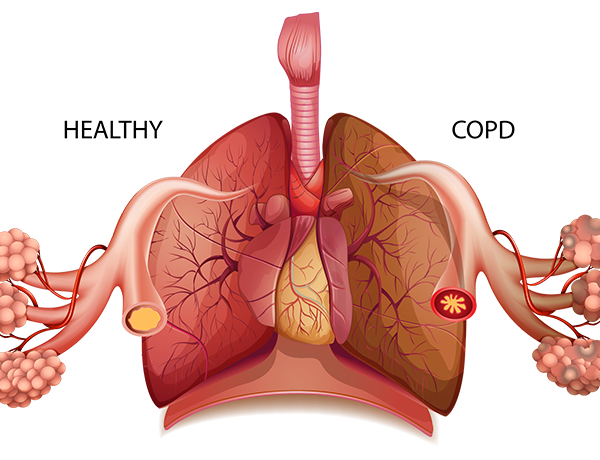National COPD Awareness Month
 More than 11 million people in the United States are known to have the advanced lung disease chronic obstructive pulmonary disease (COPD). Moreover, experts believe that many more may not be diagnosed. This common condition, the third leading cause of death in the US, inhibits the flow of air into and out of the lungs, making it harder to breathe over time.
More than 11 million people in the United States are known to have the advanced lung disease chronic obstructive pulmonary disease (COPD). Moreover, experts believe that many more may not be diagnosed. This common condition, the third leading cause of death in the US, inhibits the flow of air into and out of the lungs, making it harder to breathe over time.
COPD cannot be reversed, and there is currently no cure. However, with early detection, proper treatment, and some lifestyle changes, patients can slow its progression and breathe their best. For National COPD Awareness Month this November, learn more about this disease, signs to watch out for, and the number-one thing that patients can do to better manage their condition.
COPD Causes and Effects
The predominant cause of COPD is smoking. Tobacco smoke brings toxins and harmful particles into the lungs; over time, they cause permanent damage to the lung tissue. However, other outside factors can also lead to COPD, such as exposure to secondhand smoke, unclean air, or dust and fumes. COPD can also be generated from inside the body, from causes such as the effects of frequent asthma flare-ups and very rare genetic conditions.
The damage caused by COPD comes in multiple forms. The airways leading to the lungs narrow and/or get blocked with mucus. Inside the lungs, air sacs normally take in oxygen and send out carbon dioxide, but in COPD, this tissue breaks down. With less oxygen for fuel, the systems of the body get weaker, including blood circulation and muscle function. Therefore, patients with COPD must work harder to inhale and exhale, and are more prone to feeling tired or short of breath.
Symptoms and Diagnosis
Many patients are not diagnosed with COPD until the disease is advanced enough that its symptoms are interfering with daily life. Signs to watch for include:
- Having to stop and catch your breath during everyday tasks
- A nagging cough, or wheezing sounds
- More mucus than normal, or a change in mucus color or thickness
- Getting tired easily, or feeling sleepy or exhausted
- Frequent respiratory infections (feeling like you always have a cold)
Diagnosis of COPD involves testing through a procedure called spirometry. During the test, patients blow air into a mouthpiece attached to a small machine, which calculates the amount and speed of the air blown out. Other procedures that may also be done in order to make a diagnosis include chest X-ray and/or blood testing.
Disease Treatment and Management
Although there is no cure for COPD, there are some medical interventions that can help slow progression and reduce symptoms. Medications to aid in breathing, supplemental oxygen, and in some cases surgery may be used to help treat COPD.
However, perhaps the most important actions are those that patients can take in their daily lives, including:
- Quitting smoking: For COPD patients who smoke, quitting is almost certainly the biggest improvement they can make. Quitting helps medications work better, boosts heart health and immunity, and drastically decreases the rate of damage to the lungs.
- Seeking quality air: Because lungs have a direct connection to the outside world, it’s important to give them the healthiest possible air. Avoiding secondhand smoke, smog, dust, chemical fumes, high humidity, and extreme temperatures make breathing easier. At home, change furnace filters regularly, or consider an air purifier.
- Healthy diet and activity: For patients who may be overweight, losing weight can lessen pressure on the systems of the body, including the lungs. Underweight patients may need more calorie-rich foods to maintain a healthy weight. Physical exercise can have tremendous benefits; programs such as cardiopulmonary rehabilitation are tailored especially to help patients with chronic heart or lung disease make substantial physical gains.
If left uncontrolled, COPD can escalate until the person has an exacerbation (when symptoms get so severe that emergency care is needed). But with knowledge, appropriate treatment, attention to symptoms, healthy choices, and adequate support from caregivers and clinicians, patients with this disease can minimize their symptoms and stay safe and independent right at home.
No matter what your health challenge may be, Residential offers a range of services to help you work toward your health goals safely at home. Call (888)930-WELL (9355) to discuss your specific situation with a Home Care Specialist today, or click the image below to take our 60-second, 15-question Home Care Assessment.
{{cta(‘3073a01b-4a0b-41c6-91c0-460ecd8e3277’)}}

